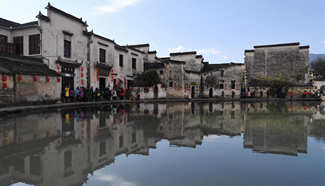HANGZHOU, Nov. 24 (Xinhua) -- When Luo and her husband went for a hike in the mountainous southwestern province of Yunnan, in 2006, neither had the slightest idea that a stroll in the countryside would change their lives, and the lives of the few remaining residents of Mangjiao, a Hani ethnic minority village, forever.
"It was a kind of ghost town. The old buildings were derelict or decaying. Most of the people had left to work in big cities or moved to more comfortable accommodation in nearby towns," Luo said.
At an awards ceremony on Tuesday in east China's Zhejiang Province, people from different walks of life were honored for protecting China's vanishing villages, Luo among them.
Identifying as Hani themselves, albeit highly urbanized, there and then, Luo and her husband decided to help improve the village. So they sold their house and began raising money.
Populated by the Aki people, a distinctive subgroup of the Hani, Mangjiao was the last village in China where the ethnic group still lived a traditional lifestyle.
Since the "adoption," Luo has worked tirelessly to keep Mangjiao architecturally and culturally intact. The couple helped the local government solve a drinking water crisis. They set up a cultural museum and rebuilt a distinctive drum temple.
"We also made a documentary about the buildings, the lives of the people, their festivals and traditions," Luo added.
The Aki people have no written language, so the buildings have a particular historical importance. "Every building in the village had stood the test of time. We could not just let them disappear, and a whole culture along with them." Luo said."
China's traditional villages are disappearing as hundreds of millions of people move to the cities. The number of villages plummeted from 3.63 million to 2.71 million in ten years from 2000. With only about half of the remaining 5,000 traditional villages under state protection, the outlook for the rest is bleak, unless people like Luo come to their aid.
TRADITION VS. URBANIZATION
Chen Shisheng has been restoring traditional buildings since he was 13, and is concerned about a lack of young people who want to take up the trade.
"These days it's mostly old men doing the work. Young people just don't bother," said Chen, 55, a resident of Huian County, east China's Fujian Province. Chen has trained 60 apprentices, most of them senior citizens.
"Restoration work requires time and patience, but the young leave the village and move to coastal areas for work," Chen said. "Who is going to repair these buildings in the future?"
It is a similar situation in Shiwukeng Village in east China's Anhui Province, where tea-making, bee-keeping and building treehouses are dying arts.
With 600 years of history, the remote village has been plagued by poverty for years and fallen into disrepair.
"Ten years ago, the village was home to 900 people, but a new road meant more than 500 people were relocated. Their houses were forgotten and abandoned," said Lyu Huayi, head of the village.
Restoring buildings is expensive, and many villages are gradually perishing. "In recent years, some money has arrived from tourism developers, but a full recovery will take time," Lyu added.
Author Feng Jicai compared the situation to that depicted by Qian Zhongshu in his novel "Fortress Besieged."
"Those who are outside want to get in, and those who are inside want to get out," he said. Residents want to go to big cities where they find indoor plumbing and shopping malls, while developers want to make money from rural tourism.
About 300 million migrant workers have left their rural villages. A recent survey by Central South University found that traditional villages of historic, ethnic or architectural values were vanishing at a rate of three per day along the Yangtze and Yellow rivers.
GOVERNMENTS ON THE MOVE
As urgency mounts, a range of measures are underway. A nationwide program to protect traditional villages began in 2012. In late 2015, each of the 2,555 villages on a national list of the most important traditional villages received three million yuan (430,000 U.S. dollars) in subsidies from the Ministry of Housing and Urban-Rural Development.
"The next priorities are to improve legislation, to set up a mechanism to protect villages and channel more money into the program," said Zhao Hui, chief economist at the ministry.
The government could put more villages on the list, come up with new policies and support those who who are expert in traditional repair techniques, Zhao said.
Local governments also have their parts to play. In May, for instance, Lhasa, capital of Tibet Autonomous Region, passed a law stipulating principles for protection, restoration and funding. Lhasa has 1,123 villages, unique in landscape, culture and tradition. As the local economy speeds up, many are yet to be protected. The law sets out responsibilities, establishes a long-term protection mechanism and encourages volunteer groups to help.
"The law will enhance protection of precious cultural resources in Lhasa," said Zhang Hui of Lhasa Municipal People's Congress.
New laws and public money can only do so much to help. In Anhui's Zuyuan Village, the beautiful landscape has made the village popular with tourists. A Shanghai company recently spent 50 million yuan on restoration work, mainly converting abandoned houses into home stays and inviting tourists for "a natural ecological experience."
Chen Jiteng, a preservation expert, believes that when maintaining villages, it is important to keep what makes them unique, such as culture or language.
"Only in this way can we stop villages disappearing," he said.










